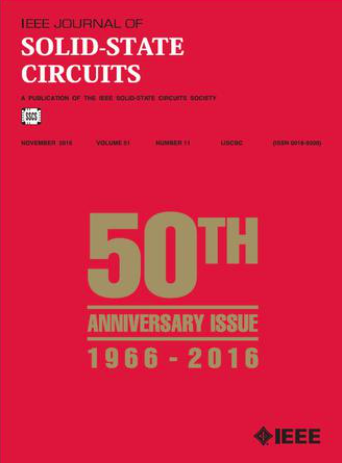A 112-Gb/s PAM-4 Retimer Transceiver With Jitter-Filtering Clocking Scheme and BER Optimization Technique in 28-nm CMOS
IF 4.6
1区 工程技术
Q1 ENGINEERING, ELECTRICAL & ELECTRONIC
引用次数: 0
Abstract
This article presents a 112-Gb/s four-level pulse amplitude modulation (PAM-4) analog-to-digital converter (ADC)-digital signal processing (DSP)-based retimer transceiver for reaching-distance extension. An injection-locked oscillator (ILO)-based jitter-filtering clocking scheme with relaxed bandwidth limitation and low-power consumption is proposed to obtain synchronous low-jitter clocks. The transmitter (TX) utilizes an internal feed-forward equalizer (FFE) cascaded with a forward-coupling pad driver to improve the output inter-symbol interference (ISI) jitter, and a timing-optimized 4:1 multiplexer (MUX) to reduce the serialization jitter. The receiver (RX) combines a flexible continuous-time linear equalizer (CTLE), a signal-to-noise ratio (SNR)-optimized ADC with 8-bit quantization, and a high-resolution digital equalization to further minimize the bit-error rate (BER). Fabricated in a 28-nm CMOS process, the prototype transceiver achieves 1E-12 raw BER at 112 Gb/s while compensating 31.2-dB channel loss. The clock network delivers a rms recovered clock jitter of 252 fs and a power efficiency of 0.56 pJ/bit, which outperforms other state-of-the-art works.基于抖动滤波时钟和误码率优化技术的122gb /s PAM-4重定时器收发器
本文提出了一种基于112gb /s四电平脉冲调幅(PAM-4)模数转换器(ADC)-数字信号处理(DSP)的中继收发器。为了获得同步低抖动时钟,提出了一种基于注入锁定振荡器(ILO)的带宽限制宽松、功耗低的抖动滤波时钟方案。发射器(TX)利用内部前馈均衡器(FFE)与前向耦合pad驱动器级联来改善输出符号间干扰(ISI)抖动,并使用时序优化的4:1多路复用器(MUX)来减少串行抖动。接收机(RX)结合了一个灵活的连续时间线性均衡器(CTLE)、一个具有8位量化的信噪比(SNR)优化ADC和一个高分辨率数字均衡,以进一步降低误码率(BER)。该原型收发器采用28纳米CMOS工艺制造,在补偿31.2 db信道损耗的同时,以112 Gb/s的速度实现了1E-12的原始误码率。时钟网络的时钟抖动有效值为252fs,功率效率为0.56 pJ/bit,优于其他最先进的工作。
本文章由计算机程序翻译,如有差异,请以英文原文为准。
求助全文
约1分钟内获得全文
求助全文
来源期刊

IEEE Journal of Solid-state Circuits
工程技术-工程:电子与电气
CiteScore
11.00
自引率
20.40%
发文量
351
审稿时长
3-6 weeks
期刊介绍:
The IEEE Journal of Solid-State Circuits publishes papers each month in the broad area of solid-state circuits with particular emphasis on transistor-level design of integrated circuits. It also provides coverage of topics such as circuits modeling, technology, systems design, layout, and testing that relate directly to IC design. Integrated circuits and VLSI are of principal interest; material related to discrete circuit design is seldom published. Experimental verification is strongly encouraged.
 求助内容:
求助内容: 应助结果提醒方式:
应助结果提醒方式:


